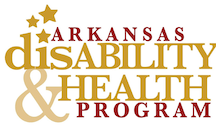
Arkansas Disability and Health Trail Assessment Project History
Public Health Issue
In 2017, it was estimated that roughly 19.8%, or 477,462 of adults with a disability in Arkansas have a mobility limitation. Arkansans with mobility limitations are less likely to get physical activity, and more likely to be obese. The 2018 Physical Activity Guidelines for Americans recommends at least 150 minutes (2 hours and 30 minutes) of moderate intensity physical activity throughout the week. Lack physical activity can contribute to obesity, and these two risk factors coupled together can contribute to chronic conditions such as cardiovascular disease, some cancers, diabetes, and more.

Program Overview
CDC funds the Arkansas Disability and Health Program (ADHP) to implement strategies to increase accessibility which results in opportunities for people with mobility limitations to get the recommended amount of physical activity every person needs. Recognizing the need for accessibility of trails and parks, the ADHP worked with members of Boy Scout Troup 160, out of Harrison, Arkansas, to provide them with the education they needed to complete the requirements of the Boy Scouts of America (BSA) Disabilities Awareness merit badge. First offered in 1993, earning the Disability Awareness badge consisted of several components, including learning about disabilities, adaptive equipment, and proper disability etiquette; visiting an agency that works with people with disabilities; and observing the accessibility of a local public area.
Originally, the project was developed by the Joe T. Robinson Middle School and their Environmental and Special Technology (EAST) program to build on student knowledge and awareness of barriers people with mobility limitations face while trying to access local parks and trails. These students assessed numerous trails throughout Central Arkansas, and gave the project a bolstering start.
The project then expanded to include other EAST programs across the state, LEND trainees, and other volunteers who have surveyed trails
Later, Scouts BSA Troup 160 joined the project, and met with Brandy Sandersfeld, ADHP Manager and registered BSA Merit Counselor, to learn about disabilities and how to survey a trail for accessibility. In collaboration with ADHP, the troop surveyed three separate trails along the Buffalo River in Newton County, Arkansas. They used a survey checklist of suggested accessibility guidelines for trails, marking barriers along the way. Throughout the survey of the trail, the troop filmed the trail from the perspective of a person using a wheelchair with a 360o camera. The troop submitted their findings and footage to the ADHP, which ADHP plans to use and build upon to increase accessibility of the trails.
The combined trail information, along with information on how to assess a trail yourself has all been compiled online for public access.
Location
10809 Executive Center Drive
Searcy Building, Suite 316
Little Rock, AR 72211
Accessibility
We are committed to creating an accessible website. If you encounter barriers that result from the design of this site or the materials provided, please contact us at partners@uark.edu.